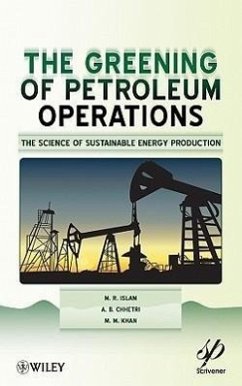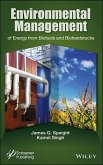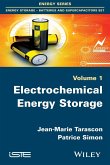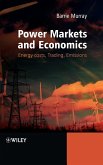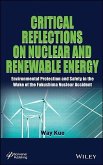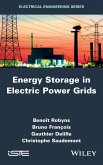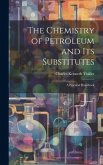M R Islam, A B Chhetri, M M Khan
The Greening of Petroleum Operations
The Science of Sustainable Energy Production
M R Islam, A B Chhetri, M M Khan
The Greening of Petroleum Operations
The Science of Sustainable Energy Production
- Gebundenes Buch
- Merkliste
- Auf die Merkliste
- Bewerten Bewerten
- Teilen
- Produkt teilen
- Produkterinnerung
- Produkterinnerung
The Future of Petroleum Operations This state-of-the-art text analyzes some of the most contentious issues in the energy industry, covering new and greener processes for engineers and scientists and urging them to move petroleum operations closer to sustainability. Although petroleum is still the world's most diverse, efficient, and abundant energy source, there is a growing initiative from global political and industry leaders to "go green," because of climate concerns and high gasoline prices. This book investigates and details how to do that. This groundbreaking new volume: Explains why…mehr
Andere Kunden interessierten sich auch für
![Environmental Management of Energy from Biofuels and Biofeedstocks Environmental Management of Energy from Biofuels and Biofeedstocks]() James G SpeightEnvironmental Management of Energy from Biofuels and Biofeedstocks243,99 €
James G SpeightEnvironmental Management of Energy from Biofuels and Biofeedstocks243,99 €![The Gas Engineer's Laboratory Handbook The Gas Engineer's Laboratory Handbook]() John HornbyThe Gas Engineer's Laboratory Handbook38,99 €
John HornbyThe Gas Engineer's Laboratory Handbook38,99 €![Electrochemical Energy Storage Electrochemical Energy Storage]() Jean-Marie TarasconElectrochemical Energy Storage187,99 €
Jean-Marie TarasconElectrochemical Energy Storage187,99 €![Power Markets and Economics Power Markets and Economics]() Barrie MurrayPower Markets and Economics127,99 €
Barrie MurrayPower Markets and Economics127,99 €![Critical Reflections on Nuclear and Renewable Energy Critical Reflections on Nuclear and Renewable Energy]() Way KuoCritical Reflections on Nuclear and Renewable Energy38,99 €
Way KuoCritical Reflections on Nuclear and Renewable Energy38,99 €![Energy Storage in Electric Power Grids Energy Storage in Electric Power Grids]() Benoît RobynsEnergy Storage in Electric Power Grids187,99 €
Benoît RobynsEnergy Storage in Electric Power Grids187,99 €![The Chemistry of Petroleum and Its Substitutes The Chemistry of Petroleum and Its Substitutes]() Charles Kenneth TinklerThe Chemistry of Petroleum and Its Substitutes40,99 €
Charles Kenneth TinklerThe Chemistry of Petroleum and Its Substitutes40,99 €-
-
-
The Future of Petroleum Operations This state-of-the-art text analyzes some of the most contentious issues in the energy industry, covering new and greener processes for engineers and scientists and urging them to move petroleum operations closer to sustainability. Although petroleum is still the world's most diverse, efficient, and abundant energy source, there is a growing initiative from global political and industry leaders to "go green," because of climate concerns and high gasoline prices. This book investigates and details how to do that. This groundbreaking new volume: Explains why current petroleum industry practices are inherently unsustainable and offers unique new solutions for "greening" the petroleum industry Discusses hot-button issues, such as global warming, carbon sequestration, zero-waste management, and sustainability Shows engineers and scientists how to implement the processes necessary to be more environmentally conscious Offers, for the first time, a new theory that certain carbons do not contribute to global warming, but their origin and the processes involved do Praise for "The Greening of Petroleum Operations" "The book proposes a paradigm shift in energy management. It correctly identifies root causes of environmental impact of current petroleum production operations. With proper science, the book shows that fossil fuel production and utilization are inherently sustainable as long as natural materials and energy sources are used.... This book has the potential of revolutionizing energy management practices." —Farouq Ali, Honorary Professor of Oil and Gas Engineering, University of Calgary
Hinweis: Dieser Artikel kann nur an eine deutsche Lieferadresse ausgeliefert werden.
Hinweis: Dieser Artikel kann nur an eine deutsche Lieferadresse ausgeliefert werden.
Produktdetails
- Produktdetails
- Verlag: Wiley
- Seitenzahl: 882
- Erscheinungstermin: 16. August 2010
- Englisch
- Abmessung: 236mm x 160mm x 46mm
- Gewicht: 1338g
- ISBN-13: 9780470625903
- ISBN-10: 0470625902
- Artikelnr.: 29923516
- Herstellerkennzeichnung
- Libri GmbH
- Europaallee 1
- 36244 Bad Hersfeld
- gpsr@libri.de
- Verlag: Wiley
- Seitenzahl: 882
- Erscheinungstermin: 16. August 2010
- Englisch
- Abmessung: 236mm x 160mm x 46mm
- Gewicht: 1338g
- ISBN-13: 9780470625903
- ISBN-10: 0470625902
- Artikelnr.: 29923516
- Herstellerkennzeichnung
- Libri GmbH
- Europaallee 1
- 36244 Bad Hersfeld
- gpsr@libri.de
M. R. Islam is Professor of Petroleum Engineering at the Civil and Resource Engineering Department of Dalhousie University, Canada. He has over 700 publications to his credit, including 6 books. He is on the boards of several scholarly journals, and, in addition to his teaching duties, he is also the director of Emertec Research and Development Ltd. and has been on the boards of a number of companies in North America and overseas. M. M. Khan has recently been a lecturer in chemical engineering at the Bangladesh University of Engineering and Technology before recently moving to Canada. He has written a dozen papers and co-authored a book on zero-waste engineering and sustainable technology. A. B. Chhetri is a Carbon and Energy Analyst with Golder Associates Ltd. in Victoria, B.C. Canada where he delivers consulting services in carbon and energy management. He has over 12 years of experience in energy development and management.
Foreword.
1 Introduction.
1.1 The Science of Change: How Will Our Epoch Be Remembered?
1.2 Are Natural Resources Finite and Human Needs Infinite?
1.3 The Standard of Sustainable Engineering.
1.4 Can Nature Be Treated as If It Were Static?
1.5 Can Human Intervention Affect Long-term Sustainability of Nature?
1.6 Can an Energy Source Be Isolated from Matter?
1.7 Is It Possible That Air, Water, and Earth Became Our Enemy?
1.8 The Difference Between Sustainable and Unsustainable Products.
1.9 Can We Compare Diamonds with Enriched Uranium?
1.10 Is Zero-waste an Absurd Concept?
1.11 How Can We Determine Whether Natural Energy Sources Last Forever?
1.12 Can Doing Good Be Bad Business?
1.13 Greening of Petroleum Operations: A Fiction?
2 A Delinearized History of Civilization and the Science of Matter and
Energy.
2.1 Introduction.
2.2 Fundamental Misconceptions of the Modern Age.
2.3 The Science of Intangibles.
2.4 The Science of Matter and Energy.
2.5 Paradigm Shift in Scientific and bEngineering Calculations.
2.6 Summary and Conclusions.
3 Fundamentals of Mass and Energy Balance.
3.1 Introduction.
3.2 The Difference Between a Natural Process and an Engineered Process.
3.3 The Measurement Conundrum of the Phenomenon and its Observer.
3.4 Implications of Einstein's Theory of Relativity on Newtonian Mechanics.
3.5 Newton's First Assumption.
3.6 First Level of Rectification of Newton's First Assumption.
3.7 Second Level of Rectification of Newton's First Assumption.
3.8 Fundamental Assumptions of Electromagnetic Theory.
3.9 Aims of Modeling Natural Phenomena.
3.10 Challenges of Modeling Sustainable Petroleum Operations.
3.11 Implications of a Knowledge-based Sustainability Analysis.
3.12 Concluding remarks.
4 A True Sustainability Criterion and Its Implications.
4.1 Introduction.
4.2 Importance of the Sustainability Criterion.
4.3 The Criterion: The Switch that Determines the Direction at a
Bifurcation Point.
4.4 Current Practices in Petroleum Engineering.
4.5 Development of a Sustainable Model.
4.6 Violation of Characteristic Time.
4.7 Observation of Nature: Importance of Intangibles.
4.8 Analogy of Physical Phenomena.
4.9 Intangible Cause to Tangible Consequence.
4.10 Removable Discontinuities: Phases and Renewability of Materials.
4.11 Rebalancing Mass and Energy.
4.12 Energy: The Current Model.
4.13 Tools Needed for Sustainable Petroleum Operations.
4.14 Conditions of Sustainability.
4.15 Sustainability Indicators.
4.16 Assessing the Overall Performance of a Process.
4.17 Inherent Features of a Comprehensive Criterion.
5 Scientific Characterization of Global Energy Sources.
5.1 Introduction.
5.2 Global Energy Scenario.
5.3 Solar Energy.
5.4 Hydropower.
5.5 Ocean Thermal, Wave, and Tidal Energy.
5.6 Wind Energy.
5.7 Bio-energy.
5.8 Fuelwood.
5.9 Bioethanol.
5.10 Biodiesel.
5.11 Nuclear Power.
5.12 Geothermal Energy.
5.13 Hydrogen Energy.
5.14 Carbon Dioxide and Global Warming.
5.15 Nuclear Energy and Global Warming.
5.16 Impact of Energy Technology and Policy.
5.17 Energy Demand in Emerging Economies.
5.18 Conventional Global Energy Model.
5.19 Renewable vs. Non-renewable: No Boundary as Such.
5.20 Knowledge-based Global Energy Model.
5.21 Concluding Remarks.
6 Scientific Characterization of Light and Light Sources.
6.1 Introduction.
6.2 Natural Light Source: The Sun.
6.3 Artificial Light Sources.
6.4 Pathways of Light.
6.5 Light Energy Model.
6.6 Spectral Analysis of Light.
6.7 Effect of Lamp Coating on Light Spectra.
6.8 Effect of Eyeglasses and Sunglasses on Light Spectra.
6.9 Concluding Remarks.
7 The Science of Global Warming.
7.1 Introduction.
7.2 Historical Development.
7.3 Current Status of Greenhouse Gas Emissions.
7.4 Comments on Copenhagen Summit.
7.5 Classification of CO2.
7.6 The Role of Water in Global Warming.
7.7 Characterization of Energy Sources.
7.8 The Kyoto Protocol.
7.9 Sustainable Energy Development.
7.10 Zero Waste Energy Systems.
7.11 Reversing Global Warming: The Role of Technology Development.
7.12 Deconstructing the Myth of G loba 1 Warming and Cooling.
7.13 Concluding Remarks.
8 Diverging Fates of Sustainable and Unsustainable Products.
8.1 Introduction.
8.2 Chemical Composition of Polyurethane Fiber.
8.3 Biochemical Composition of Wool.
8.4 Pathways of Polyurethane.
8.5 Pathways of Wool.
8.6 Degradation of Polyurethane.
8.7 Degradation of Wools.
8.8 Recycling Polyurethane Waste.
8.9 Unsustainable Technologies.
8.10 Toxic Compounds from Plastic.
8.11 Environmental Impacts Issues.
8.12 How Much is Known?
8.13 Concluding Remarks.
9 Scientific Difference Between Sustainable and Unsustainable Processes.
9.1 Introduction.
9.2 Physical Properties of Beeswax and Paraffin Wax.
9.3 Microstructures of Beeswax and Paraffin wax.
9.4 Structural Analysis of Paraffin Wax and Beeswax.
9.5 Response to Uniaxial Compression.
9.6 Ultrasonic Tests on Beeswax and Paraffin Wax.
9.7 Natural Plastic and Synthetic Plastic.
9.8 Plastic Pathway from Crude Oil.
9.9 Theoretical Comparison Between Nylon and Silk.
9.10 Theoretical Comparison Between Synthetic Rubber and Latex (Natural
Rubber).
9.11 Concluding Remarks.
10 Comparison of Various Energy Production Schemes.
10.1 Introduction.
10.2 Inherent Features of a Comprehensive Criterion.
10.3 The Need for a Multidimensional Study.
10.4 Assessing the Overall Performance of a Process.
10.5 Global Efficiency of Solar Energy to Electricity Conversion.
10.6 Global Efficiency of Biomass Energy.
10.7 Global efficiency of nuclear power.
10.8 Discussion.
10.9 Concluding remarks.
11 The Zero-Waste Concept and its Application to Petroleum Engineering.
11.1 Introduction.
11.2 Petroleum Refining.
11.3 Zero Waste in Product Life Cycle (Transportation, Use, and
End-of-Life).
11.4 No-Flaring Technique.
12 Sustainable Refining and Gas Processing.
12.1 Introduction.
12.2 Pathways of Crude Oil Formation.
12.3 Pathways of Crude Oil Refining.
12.4 Additives in Oil Refining and Their Functions.
12.5 Emissions from Oil Refining Activities.
12.6 Degradation of Crude and Refined Oil.
12.7 Pathways of Natural Gas Processing.
12.8 Oil and Condensate Removal from Gas Streams.
12.9 Water Removal from Gas Streams.
12.10 Separation of Natural Gas Liquids.
12.11 Sulfur and Carbon Dioxide Removal.
12.12 Problems in Natural Gas Processing.
12.13 Innovative Solutions for Natural Gas Processing.
12.14 Concluding Remarks.
13 Flow Assurance in Petroleum Fluids.
13.1 Introduction.
13.2 The Prevention of Hydrate Formation.
13.3 Problems with the Gas-processing Chemicals.
13.4 Pathways of Chemical Additives.
13.5 Sustainable Alternatives to Conventional Techniques for Hydrate
Prevention.
13.6 Mechanism of Microbially Induced Corrosion.
13.7 Sustainable Approach to Corrosion Prevention.
13.8 Asphaltene Problems and Sustainable Mitigation.
14 Sustainable Enhanced Oil Recovery.
14.1 Introduction.
14.2 Chemical Flooding Agents.
14.3 Rendering CO2Injection Sustainable.
14.4 A Novel Microbial Technique.
14.5 Humanizing EOR Practices.
15 The Knowledge Economics.
15.1 Introduction.
15.2 The Economics of Sustainable Engineering.
15.3 The New Synthesis.
15.4 A Case of Zero-waste Engineering.
16 Deconstniction of Engineering Myths Prevalent in the Energy Sector.
16.1 Introduction.
16.2 The Sustainable Biofuel Fantasy.
16.3 "Clean" Nuclear Energy 720
17 Greening of Petroleum Operations.
17.1 Introduction.
17.2 Issues in Petroleum Operations.
17.3 Pathway Analysis of Crude and Refined Oil and Gas.
17.4 Critical Evaluation of Current Petroleum Practices.
17.5 Management.
17.6 Current Practices in Exploration, Drilling, and Production.
17.7 Challenges in Waste Management.
17.8 Problems in Transportation Operations.
17.9 Greening of Petroleum Operations.
17.10 Concluding Remarks.
18 Conclusion.
18.1 Introduction.
> Sugar > Saccharin > Aspartame) Pathway.
18.3 HSSA Pathway in Energy Management.
18.4 The Conclusions.
Appendix 1 Origin of Atomic Theory as Viewed by the European Scientists.
Appendix 2 Nobel Prize in Physics (2008) given for discovering breakdown of
symmetry.
References and Bibliography.
Index.
1 Introduction.
1.1 The Science of Change: How Will Our Epoch Be Remembered?
1.2 Are Natural Resources Finite and Human Needs Infinite?
1.3 The Standard of Sustainable Engineering.
1.4 Can Nature Be Treated as If It Were Static?
1.5 Can Human Intervention Affect Long-term Sustainability of Nature?
1.6 Can an Energy Source Be Isolated from Matter?
1.7 Is It Possible That Air, Water, and Earth Became Our Enemy?
1.8 The Difference Between Sustainable and Unsustainable Products.
1.9 Can We Compare Diamonds with Enriched Uranium?
1.10 Is Zero-waste an Absurd Concept?
1.11 How Can We Determine Whether Natural Energy Sources Last Forever?
1.12 Can Doing Good Be Bad Business?
1.13 Greening of Petroleum Operations: A Fiction?
2 A Delinearized History of Civilization and the Science of Matter and
Energy.
2.1 Introduction.
2.2 Fundamental Misconceptions of the Modern Age.
2.3 The Science of Intangibles.
2.4 The Science of Matter and Energy.
2.5 Paradigm Shift in Scientific and bEngineering Calculations.
2.6 Summary and Conclusions.
3 Fundamentals of Mass and Energy Balance.
3.1 Introduction.
3.2 The Difference Between a Natural Process and an Engineered Process.
3.3 The Measurement Conundrum of the Phenomenon and its Observer.
3.4 Implications of Einstein's Theory of Relativity on Newtonian Mechanics.
3.5 Newton's First Assumption.
3.6 First Level of Rectification of Newton's First Assumption.
3.7 Second Level of Rectification of Newton's First Assumption.
3.8 Fundamental Assumptions of Electromagnetic Theory.
3.9 Aims of Modeling Natural Phenomena.
3.10 Challenges of Modeling Sustainable Petroleum Operations.
3.11 Implications of a Knowledge-based Sustainability Analysis.
3.12 Concluding remarks.
4 A True Sustainability Criterion and Its Implications.
4.1 Introduction.
4.2 Importance of the Sustainability Criterion.
4.3 The Criterion: The Switch that Determines the Direction at a
Bifurcation Point.
4.4 Current Practices in Petroleum Engineering.
4.5 Development of a Sustainable Model.
4.6 Violation of Characteristic Time.
4.7 Observation of Nature: Importance of Intangibles.
4.8 Analogy of Physical Phenomena.
4.9 Intangible Cause to Tangible Consequence.
4.10 Removable Discontinuities: Phases and Renewability of Materials.
4.11 Rebalancing Mass and Energy.
4.12 Energy: The Current Model.
4.13 Tools Needed for Sustainable Petroleum Operations.
4.14 Conditions of Sustainability.
4.15 Sustainability Indicators.
4.16 Assessing the Overall Performance of a Process.
4.17 Inherent Features of a Comprehensive Criterion.
5 Scientific Characterization of Global Energy Sources.
5.1 Introduction.
5.2 Global Energy Scenario.
5.3 Solar Energy.
5.4 Hydropower.
5.5 Ocean Thermal, Wave, and Tidal Energy.
5.6 Wind Energy.
5.7 Bio-energy.
5.8 Fuelwood.
5.9 Bioethanol.
5.10 Biodiesel.
5.11 Nuclear Power.
5.12 Geothermal Energy.
5.13 Hydrogen Energy.
5.14 Carbon Dioxide and Global Warming.
5.15 Nuclear Energy and Global Warming.
5.16 Impact of Energy Technology and Policy.
5.17 Energy Demand in Emerging Economies.
5.18 Conventional Global Energy Model.
5.19 Renewable vs. Non-renewable: No Boundary as Such.
5.20 Knowledge-based Global Energy Model.
5.21 Concluding Remarks.
6 Scientific Characterization of Light and Light Sources.
6.1 Introduction.
6.2 Natural Light Source: The Sun.
6.3 Artificial Light Sources.
6.4 Pathways of Light.
6.5 Light Energy Model.
6.6 Spectral Analysis of Light.
6.7 Effect of Lamp Coating on Light Spectra.
6.8 Effect of Eyeglasses and Sunglasses on Light Spectra.
6.9 Concluding Remarks.
7 The Science of Global Warming.
7.1 Introduction.
7.2 Historical Development.
7.3 Current Status of Greenhouse Gas Emissions.
7.4 Comments on Copenhagen Summit.
7.5 Classification of CO2.
7.6 The Role of Water in Global Warming.
7.7 Characterization of Energy Sources.
7.8 The Kyoto Protocol.
7.9 Sustainable Energy Development.
7.10 Zero Waste Energy Systems.
7.11 Reversing Global Warming: The Role of Technology Development.
7.12 Deconstructing the Myth of G loba 1 Warming and Cooling.
7.13 Concluding Remarks.
8 Diverging Fates of Sustainable and Unsustainable Products.
8.1 Introduction.
8.2 Chemical Composition of Polyurethane Fiber.
8.3 Biochemical Composition of Wool.
8.4 Pathways of Polyurethane.
8.5 Pathways of Wool.
8.6 Degradation of Polyurethane.
8.7 Degradation of Wools.
8.8 Recycling Polyurethane Waste.
8.9 Unsustainable Technologies.
8.10 Toxic Compounds from Plastic.
8.11 Environmental Impacts Issues.
8.12 How Much is Known?
8.13 Concluding Remarks.
9 Scientific Difference Between Sustainable and Unsustainable Processes.
9.1 Introduction.
9.2 Physical Properties of Beeswax and Paraffin Wax.
9.3 Microstructures of Beeswax and Paraffin wax.
9.4 Structural Analysis of Paraffin Wax and Beeswax.
9.5 Response to Uniaxial Compression.
9.6 Ultrasonic Tests on Beeswax and Paraffin Wax.
9.7 Natural Plastic and Synthetic Plastic.
9.8 Plastic Pathway from Crude Oil.
9.9 Theoretical Comparison Between Nylon and Silk.
9.10 Theoretical Comparison Between Synthetic Rubber and Latex (Natural
Rubber).
9.11 Concluding Remarks.
10 Comparison of Various Energy Production Schemes.
10.1 Introduction.
10.2 Inherent Features of a Comprehensive Criterion.
10.3 The Need for a Multidimensional Study.
10.4 Assessing the Overall Performance of a Process.
10.5 Global Efficiency of Solar Energy to Electricity Conversion.
10.6 Global Efficiency of Biomass Energy.
10.7 Global efficiency of nuclear power.
10.8 Discussion.
10.9 Concluding remarks.
11 The Zero-Waste Concept and its Application to Petroleum Engineering.
11.1 Introduction.
11.2 Petroleum Refining.
11.3 Zero Waste in Product Life Cycle (Transportation, Use, and
End-of-Life).
11.4 No-Flaring Technique.
12 Sustainable Refining and Gas Processing.
12.1 Introduction.
12.2 Pathways of Crude Oil Formation.
12.3 Pathways of Crude Oil Refining.
12.4 Additives in Oil Refining and Their Functions.
12.5 Emissions from Oil Refining Activities.
12.6 Degradation of Crude and Refined Oil.
12.7 Pathways of Natural Gas Processing.
12.8 Oil and Condensate Removal from Gas Streams.
12.9 Water Removal from Gas Streams.
12.10 Separation of Natural Gas Liquids.
12.11 Sulfur and Carbon Dioxide Removal.
12.12 Problems in Natural Gas Processing.
12.13 Innovative Solutions for Natural Gas Processing.
12.14 Concluding Remarks.
13 Flow Assurance in Petroleum Fluids.
13.1 Introduction.
13.2 The Prevention of Hydrate Formation.
13.3 Problems with the Gas-processing Chemicals.
13.4 Pathways of Chemical Additives.
13.5 Sustainable Alternatives to Conventional Techniques for Hydrate
Prevention.
13.6 Mechanism of Microbially Induced Corrosion.
13.7 Sustainable Approach to Corrosion Prevention.
13.8 Asphaltene Problems and Sustainable Mitigation.
14 Sustainable Enhanced Oil Recovery.
14.1 Introduction.
14.2 Chemical Flooding Agents.
14.3 Rendering CO2Injection Sustainable.
14.4 A Novel Microbial Technique.
14.5 Humanizing EOR Practices.
15 The Knowledge Economics.
15.1 Introduction.
15.2 The Economics of Sustainable Engineering.
15.3 The New Synthesis.
15.4 A Case of Zero-waste Engineering.
16 Deconstniction of Engineering Myths Prevalent in the Energy Sector.
16.1 Introduction.
16.2 The Sustainable Biofuel Fantasy.
16.3 "Clean" Nuclear Energy 720
17 Greening of Petroleum Operations.
17.1 Introduction.
17.2 Issues in Petroleum Operations.
17.3 Pathway Analysis of Crude and Refined Oil and Gas.
17.4 Critical Evaluation of Current Petroleum Practices.
17.5 Management.
17.6 Current Practices in Exploration, Drilling, and Production.
17.7 Challenges in Waste Management.
17.8 Problems in Transportation Operations.
17.9 Greening of Petroleum Operations.
17.10 Concluding Remarks.
18 Conclusion.
18.1 Introduction.
> Sugar > Saccharin > Aspartame) Pathway.
18.3 HSSA Pathway in Energy Management.
18.4 The Conclusions.
Appendix 1 Origin of Atomic Theory as Viewed by the European Scientists.
Appendix 2 Nobel Prize in Physics (2008) given for discovering breakdown of
symmetry.
References and Bibliography.
Index.
Foreword.
1 Introduction.
1.1 The Science of Change: How Will Our Epoch Be Remembered?
1.2 Are Natural Resources Finite and Human Needs Infinite?
1.3 The Standard of Sustainable Engineering.
1.4 Can Nature Be Treated as If It Were Static?
1.5 Can Human Intervention Affect Long-term Sustainability of Nature?
1.6 Can an Energy Source Be Isolated from Matter?
1.7 Is It Possible That Air, Water, and Earth Became Our Enemy?
1.8 The Difference Between Sustainable and Unsustainable Products.
1.9 Can We Compare Diamonds with Enriched Uranium?
1.10 Is Zero-waste an Absurd Concept?
1.11 How Can We Determine Whether Natural Energy Sources Last Forever?
1.12 Can Doing Good Be Bad Business?
1.13 Greening of Petroleum Operations: A Fiction?
2 A Delinearized History of Civilization and the Science of Matter and
Energy.
2.1 Introduction.
2.2 Fundamental Misconceptions of the Modern Age.
2.3 The Science of Intangibles.
2.4 The Science of Matter and Energy.
2.5 Paradigm Shift in Scientific and bEngineering Calculations.
2.6 Summary and Conclusions.
3 Fundamentals of Mass and Energy Balance.
3.1 Introduction.
3.2 The Difference Between a Natural Process and an Engineered Process.
3.3 The Measurement Conundrum of the Phenomenon and its Observer.
3.4 Implications of Einstein's Theory of Relativity on Newtonian Mechanics.
3.5 Newton's First Assumption.
3.6 First Level of Rectification of Newton's First Assumption.
3.7 Second Level of Rectification of Newton's First Assumption.
3.8 Fundamental Assumptions of Electromagnetic Theory.
3.9 Aims of Modeling Natural Phenomena.
3.10 Challenges of Modeling Sustainable Petroleum Operations.
3.11 Implications of a Knowledge-based Sustainability Analysis.
3.12 Concluding remarks.
4 A True Sustainability Criterion and Its Implications.
4.1 Introduction.
4.2 Importance of the Sustainability Criterion.
4.3 The Criterion: The Switch that Determines the Direction at a
Bifurcation Point.
4.4 Current Practices in Petroleum Engineering.
4.5 Development of a Sustainable Model.
4.6 Violation of Characteristic Time.
4.7 Observation of Nature: Importance of Intangibles.
4.8 Analogy of Physical Phenomena.
4.9 Intangible Cause to Tangible Consequence.
4.10 Removable Discontinuities: Phases and Renewability of Materials.
4.11 Rebalancing Mass and Energy.
4.12 Energy: The Current Model.
4.13 Tools Needed for Sustainable Petroleum Operations.
4.14 Conditions of Sustainability.
4.15 Sustainability Indicators.
4.16 Assessing the Overall Performance of a Process.
4.17 Inherent Features of a Comprehensive Criterion.
5 Scientific Characterization of Global Energy Sources.
5.1 Introduction.
5.2 Global Energy Scenario.
5.3 Solar Energy.
5.4 Hydropower.
5.5 Ocean Thermal, Wave, and Tidal Energy.
5.6 Wind Energy.
5.7 Bio-energy.
5.8 Fuelwood.
5.9 Bioethanol.
5.10 Biodiesel.
5.11 Nuclear Power.
5.12 Geothermal Energy.
5.13 Hydrogen Energy.
5.14 Carbon Dioxide and Global Warming.
5.15 Nuclear Energy and Global Warming.
5.16 Impact of Energy Technology and Policy.
5.17 Energy Demand in Emerging Economies.
5.18 Conventional Global Energy Model.
5.19 Renewable vs. Non-renewable: No Boundary as Such.
5.20 Knowledge-based Global Energy Model.
5.21 Concluding Remarks.
6 Scientific Characterization of Light and Light Sources.
6.1 Introduction.
6.2 Natural Light Source: The Sun.
6.3 Artificial Light Sources.
6.4 Pathways of Light.
6.5 Light Energy Model.
6.6 Spectral Analysis of Light.
6.7 Effect of Lamp Coating on Light Spectra.
6.8 Effect of Eyeglasses and Sunglasses on Light Spectra.
6.9 Concluding Remarks.
7 The Science of Global Warming.
7.1 Introduction.
7.2 Historical Development.
7.3 Current Status of Greenhouse Gas Emissions.
7.4 Comments on Copenhagen Summit.
7.5 Classification of CO2.
7.6 The Role of Water in Global Warming.
7.7 Characterization of Energy Sources.
7.8 The Kyoto Protocol.
7.9 Sustainable Energy Development.
7.10 Zero Waste Energy Systems.
7.11 Reversing Global Warming: The Role of Technology Development.
7.12 Deconstructing the Myth of G loba 1 Warming and Cooling.
7.13 Concluding Remarks.
8 Diverging Fates of Sustainable and Unsustainable Products.
8.1 Introduction.
8.2 Chemical Composition of Polyurethane Fiber.
8.3 Biochemical Composition of Wool.
8.4 Pathways of Polyurethane.
8.5 Pathways of Wool.
8.6 Degradation of Polyurethane.
8.7 Degradation of Wools.
8.8 Recycling Polyurethane Waste.
8.9 Unsustainable Technologies.
8.10 Toxic Compounds from Plastic.
8.11 Environmental Impacts Issues.
8.12 How Much is Known?
8.13 Concluding Remarks.
9 Scientific Difference Between Sustainable and Unsustainable Processes.
9.1 Introduction.
9.2 Physical Properties of Beeswax and Paraffin Wax.
9.3 Microstructures of Beeswax and Paraffin wax.
9.4 Structural Analysis of Paraffin Wax and Beeswax.
9.5 Response to Uniaxial Compression.
9.6 Ultrasonic Tests on Beeswax and Paraffin Wax.
9.7 Natural Plastic and Synthetic Plastic.
9.8 Plastic Pathway from Crude Oil.
9.9 Theoretical Comparison Between Nylon and Silk.
9.10 Theoretical Comparison Between Synthetic Rubber and Latex (Natural
Rubber).
9.11 Concluding Remarks.
10 Comparison of Various Energy Production Schemes.
10.1 Introduction.
10.2 Inherent Features of a Comprehensive Criterion.
10.3 The Need for a Multidimensional Study.
10.4 Assessing the Overall Performance of a Process.
10.5 Global Efficiency of Solar Energy to Electricity Conversion.
10.6 Global Efficiency of Biomass Energy.
10.7 Global efficiency of nuclear power.
10.8 Discussion.
10.9 Concluding remarks.
11 The Zero-Waste Concept and its Application to Petroleum Engineering.
11.1 Introduction.
11.2 Petroleum Refining.
11.3 Zero Waste in Product Life Cycle (Transportation, Use, and
End-of-Life).
11.4 No-Flaring Technique.
12 Sustainable Refining and Gas Processing.
12.1 Introduction.
12.2 Pathways of Crude Oil Formation.
12.3 Pathways of Crude Oil Refining.
12.4 Additives in Oil Refining and Their Functions.
12.5 Emissions from Oil Refining Activities.
12.6 Degradation of Crude and Refined Oil.
12.7 Pathways of Natural Gas Processing.
12.8 Oil and Condensate Removal from Gas Streams.
12.9 Water Removal from Gas Streams.
12.10 Separation of Natural Gas Liquids.
12.11 Sulfur and Carbon Dioxide Removal.
12.12 Problems in Natural Gas Processing.
12.13 Innovative Solutions for Natural Gas Processing.
12.14 Concluding Remarks.
13 Flow Assurance in Petroleum Fluids.
13.1 Introduction.
13.2 The Prevention of Hydrate Formation.
13.3 Problems with the Gas-processing Chemicals.
13.4 Pathways of Chemical Additives.
13.5 Sustainable Alternatives to Conventional Techniques for Hydrate
Prevention.
13.6 Mechanism of Microbially Induced Corrosion.
13.7 Sustainable Approach to Corrosion Prevention.
13.8 Asphaltene Problems and Sustainable Mitigation.
14 Sustainable Enhanced Oil Recovery.
14.1 Introduction.
14.2 Chemical Flooding Agents.
14.3 Rendering CO2Injection Sustainable.
14.4 A Novel Microbial Technique.
14.5 Humanizing EOR Practices.
15 The Knowledge Economics.
15.1 Introduction.
15.2 The Economics of Sustainable Engineering.
15.3 The New Synthesis.
15.4 A Case of Zero-waste Engineering.
16 Deconstniction of Engineering Myths Prevalent in the Energy Sector.
16.1 Introduction.
16.2 The Sustainable Biofuel Fantasy.
16.3 "Clean" Nuclear Energy 720
17 Greening of Petroleum Operations.
17.1 Introduction.
17.2 Issues in Petroleum Operations.
17.3 Pathway Analysis of Crude and Refined Oil and Gas.
17.4 Critical Evaluation of Current Petroleum Practices.
17.5 Management.
17.6 Current Practices in Exploration, Drilling, and Production.
17.7 Challenges in Waste Management.
17.8 Problems in Transportation Operations.
17.9 Greening of Petroleum Operations.
17.10 Concluding Remarks.
18 Conclusion.
18.1 Introduction.
> Sugar > Saccharin > Aspartame) Pathway.
18.3 HSSA Pathway in Energy Management.
18.4 The Conclusions.
Appendix 1 Origin of Atomic Theory as Viewed by the European Scientists.
Appendix 2 Nobel Prize in Physics (2008) given for discovering breakdown of
symmetry.
References and Bibliography.
Index.
1 Introduction.
1.1 The Science of Change: How Will Our Epoch Be Remembered?
1.2 Are Natural Resources Finite and Human Needs Infinite?
1.3 The Standard of Sustainable Engineering.
1.4 Can Nature Be Treated as If It Were Static?
1.5 Can Human Intervention Affect Long-term Sustainability of Nature?
1.6 Can an Energy Source Be Isolated from Matter?
1.7 Is It Possible That Air, Water, and Earth Became Our Enemy?
1.8 The Difference Between Sustainable and Unsustainable Products.
1.9 Can We Compare Diamonds with Enriched Uranium?
1.10 Is Zero-waste an Absurd Concept?
1.11 How Can We Determine Whether Natural Energy Sources Last Forever?
1.12 Can Doing Good Be Bad Business?
1.13 Greening of Petroleum Operations: A Fiction?
2 A Delinearized History of Civilization and the Science of Matter and
Energy.
2.1 Introduction.
2.2 Fundamental Misconceptions of the Modern Age.
2.3 The Science of Intangibles.
2.4 The Science of Matter and Energy.
2.5 Paradigm Shift in Scientific and bEngineering Calculations.
2.6 Summary and Conclusions.
3 Fundamentals of Mass and Energy Balance.
3.1 Introduction.
3.2 The Difference Between a Natural Process and an Engineered Process.
3.3 The Measurement Conundrum of the Phenomenon and its Observer.
3.4 Implications of Einstein's Theory of Relativity on Newtonian Mechanics.
3.5 Newton's First Assumption.
3.6 First Level of Rectification of Newton's First Assumption.
3.7 Second Level of Rectification of Newton's First Assumption.
3.8 Fundamental Assumptions of Electromagnetic Theory.
3.9 Aims of Modeling Natural Phenomena.
3.10 Challenges of Modeling Sustainable Petroleum Operations.
3.11 Implications of a Knowledge-based Sustainability Analysis.
3.12 Concluding remarks.
4 A True Sustainability Criterion and Its Implications.
4.1 Introduction.
4.2 Importance of the Sustainability Criterion.
4.3 The Criterion: The Switch that Determines the Direction at a
Bifurcation Point.
4.4 Current Practices in Petroleum Engineering.
4.5 Development of a Sustainable Model.
4.6 Violation of Characteristic Time.
4.7 Observation of Nature: Importance of Intangibles.
4.8 Analogy of Physical Phenomena.
4.9 Intangible Cause to Tangible Consequence.
4.10 Removable Discontinuities: Phases and Renewability of Materials.
4.11 Rebalancing Mass and Energy.
4.12 Energy: The Current Model.
4.13 Tools Needed for Sustainable Petroleum Operations.
4.14 Conditions of Sustainability.
4.15 Sustainability Indicators.
4.16 Assessing the Overall Performance of a Process.
4.17 Inherent Features of a Comprehensive Criterion.
5 Scientific Characterization of Global Energy Sources.
5.1 Introduction.
5.2 Global Energy Scenario.
5.3 Solar Energy.
5.4 Hydropower.
5.5 Ocean Thermal, Wave, and Tidal Energy.
5.6 Wind Energy.
5.7 Bio-energy.
5.8 Fuelwood.
5.9 Bioethanol.
5.10 Biodiesel.
5.11 Nuclear Power.
5.12 Geothermal Energy.
5.13 Hydrogen Energy.
5.14 Carbon Dioxide and Global Warming.
5.15 Nuclear Energy and Global Warming.
5.16 Impact of Energy Technology and Policy.
5.17 Energy Demand in Emerging Economies.
5.18 Conventional Global Energy Model.
5.19 Renewable vs. Non-renewable: No Boundary as Such.
5.20 Knowledge-based Global Energy Model.
5.21 Concluding Remarks.
6 Scientific Characterization of Light and Light Sources.
6.1 Introduction.
6.2 Natural Light Source: The Sun.
6.3 Artificial Light Sources.
6.4 Pathways of Light.
6.5 Light Energy Model.
6.6 Spectral Analysis of Light.
6.7 Effect of Lamp Coating on Light Spectra.
6.8 Effect of Eyeglasses and Sunglasses on Light Spectra.
6.9 Concluding Remarks.
7 The Science of Global Warming.
7.1 Introduction.
7.2 Historical Development.
7.3 Current Status of Greenhouse Gas Emissions.
7.4 Comments on Copenhagen Summit.
7.5 Classification of CO2.
7.6 The Role of Water in Global Warming.
7.7 Characterization of Energy Sources.
7.8 The Kyoto Protocol.
7.9 Sustainable Energy Development.
7.10 Zero Waste Energy Systems.
7.11 Reversing Global Warming: The Role of Technology Development.
7.12 Deconstructing the Myth of G loba 1 Warming and Cooling.
7.13 Concluding Remarks.
8 Diverging Fates of Sustainable and Unsustainable Products.
8.1 Introduction.
8.2 Chemical Composition of Polyurethane Fiber.
8.3 Biochemical Composition of Wool.
8.4 Pathways of Polyurethane.
8.5 Pathways of Wool.
8.6 Degradation of Polyurethane.
8.7 Degradation of Wools.
8.8 Recycling Polyurethane Waste.
8.9 Unsustainable Technologies.
8.10 Toxic Compounds from Plastic.
8.11 Environmental Impacts Issues.
8.12 How Much is Known?
8.13 Concluding Remarks.
9 Scientific Difference Between Sustainable and Unsustainable Processes.
9.1 Introduction.
9.2 Physical Properties of Beeswax and Paraffin Wax.
9.3 Microstructures of Beeswax and Paraffin wax.
9.4 Structural Analysis of Paraffin Wax and Beeswax.
9.5 Response to Uniaxial Compression.
9.6 Ultrasonic Tests on Beeswax and Paraffin Wax.
9.7 Natural Plastic and Synthetic Plastic.
9.8 Plastic Pathway from Crude Oil.
9.9 Theoretical Comparison Between Nylon and Silk.
9.10 Theoretical Comparison Between Synthetic Rubber and Latex (Natural
Rubber).
9.11 Concluding Remarks.
10 Comparison of Various Energy Production Schemes.
10.1 Introduction.
10.2 Inherent Features of a Comprehensive Criterion.
10.3 The Need for a Multidimensional Study.
10.4 Assessing the Overall Performance of a Process.
10.5 Global Efficiency of Solar Energy to Electricity Conversion.
10.6 Global Efficiency of Biomass Energy.
10.7 Global efficiency of nuclear power.
10.8 Discussion.
10.9 Concluding remarks.
11 The Zero-Waste Concept and its Application to Petroleum Engineering.
11.1 Introduction.
11.2 Petroleum Refining.
11.3 Zero Waste in Product Life Cycle (Transportation, Use, and
End-of-Life).
11.4 No-Flaring Technique.
12 Sustainable Refining and Gas Processing.
12.1 Introduction.
12.2 Pathways of Crude Oil Formation.
12.3 Pathways of Crude Oil Refining.
12.4 Additives in Oil Refining and Their Functions.
12.5 Emissions from Oil Refining Activities.
12.6 Degradation of Crude and Refined Oil.
12.7 Pathways of Natural Gas Processing.
12.8 Oil and Condensate Removal from Gas Streams.
12.9 Water Removal from Gas Streams.
12.10 Separation of Natural Gas Liquids.
12.11 Sulfur and Carbon Dioxide Removal.
12.12 Problems in Natural Gas Processing.
12.13 Innovative Solutions for Natural Gas Processing.
12.14 Concluding Remarks.
13 Flow Assurance in Petroleum Fluids.
13.1 Introduction.
13.2 The Prevention of Hydrate Formation.
13.3 Problems with the Gas-processing Chemicals.
13.4 Pathways of Chemical Additives.
13.5 Sustainable Alternatives to Conventional Techniques for Hydrate
Prevention.
13.6 Mechanism of Microbially Induced Corrosion.
13.7 Sustainable Approach to Corrosion Prevention.
13.8 Asphaltene Problems and Sustainable Mitigation.
14 Sustainable Enhanced Oil Recovery.
14.1 Introduction.
14.2 Chemical Flooding Agents.
14.3 Rendering CO2Injection Sustainable.
14.4 A Novel Microbial Technique.
14.5 Humanizing EOR Practices.
15 The Knowledge Economics.
15.1 Introduction.
15.2 The Economics of Sustainable Engineering.
15.3 The New Synthesis.
15.4 A Case of Zero-waste Engineering.
16 Deconstniction of Engineering Myths Prevalent in the Energy Sector.
16.1 Introduction.
16.2 The Sustainable Biofuel Fantasy.
16.3 "Clean" Nuclear Energy 720
17 Greening of Petroleum Operations.
17.1 Introduction.
17.2 Issues in Petroleum Operations.
17.3 Pathway Analysis of Crude and Refined Oil and Gas.
17.4 Critical Evaluation of Current Petroleum Practices.
17.5 Management.
17.6 Current Practices in Exploration, Drilling, and Production.
17.7 Challenges in Waste Management.
17.8 Problems in Transportation Operations.
17.9 Greening of Petroleum Operations.
17.10 Concluding Remarks.
18 Conclusion.
18.1 Introduction.
> Sugar > Saccharin > Aspartame) Pathway.
18.3 HSSA Pathway in Energy Management.
18.4 The Conclusions.
Appendix 1 Origin of Atomic Theory as Viewed by the European Scientists.
Appendix 2 Nobel Prize in Physics (2008) given for discovering breakdown of
symmetry.
References and Bibliography.
Index.

